Navigation
Insurance scheme for resolving conflict between livestock farmers and endangered Snow Leopards.
Snow Leopards prey on the livestock of local farmers who retaliate by killing the predators. From an economic perspective, the local farmers perceive the Snow Leopards’ actions as a risk to their livelihoods and they act to eliminate that risk. In this situation the local farmers perceive the Snow Leopard as having no economic value, or worse, as having a negative value since it threatens their livelihoods.
Location:
Skoyo, Baltisan, Pakistan
Problem Overview:
Conflict between endangered Snow Leopards and farmers arising from loss of livestock due to predation
Snow Leopards prey on the livestock of local farmers who retaliate by killing the predators. From an economic perspective, the local farmers perceive the Snow Leopards’ actions as a risk to their livelihoods and they act to eliminate that risk. In this situation the local farmers perceive the Snow Leopard as having no economic value, or worse, as having a negative value since it threatens their livelihoods (Pearce, 1996).
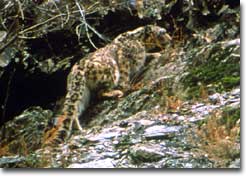 |
| Snow Leopard in Central Gol (photo by Khushal Habibi) |
The Snow Leopard, Uncia uncia, is widely but thinly distributed throughout the Central Asian mountains. Globally, the Snow Leopard is listed as Endangered in The World Conservation Union (IUCN) Red List of Threatened Species (1996), and as an Appendix I species in the Convention on International Trade in Endangered Species (CITES) checklist. The Snow Leopard population world-wide is considered to be somewhere between 3,000 - 7,000 (ISLT 1998). However, this population is under threat from retaliatory killing by local people in response to livestock predation; poaching for body parts; fragmentation and reduction of its wild prey species; and isolation of individuals (with associated gene flow bottlenecks).
Baltistan - a high mountain area of significant conservation value - in Northern Pakistan spreads over 26,000 sq. km and supports a population of approximately 300,000 people. The region is one of the poorest, in one of the poorest countries in the world and embraces some of the world's highest mountain ranges – the Western Himalayas, Karakoram and Hindu Kush - with several peaks over 8,000 metres. The flora and fauna of the region are diverse with several globally significant species represented, including the Snow Leopard (Uncia uncia), Markhor (Capra Falconeri), Himalayan Ibex (Capra ibex siberica), Blue Sheep (Pseudois nayaur), Musk Deer (Moschus moschiferus), and a range of avifauna (Roberts, 1997).
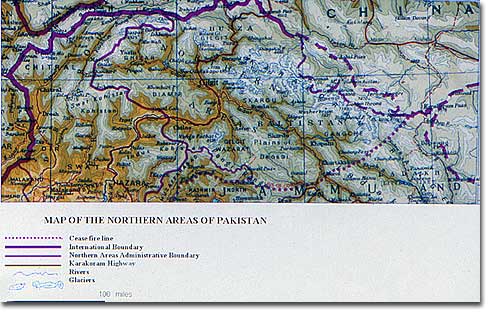 |
Local people make extensive use of the biological resources in the wild whilst relying on agriculture for vegetable, grain, fruit, forest and livestock products. Recently, reliance on migration and credit is also a part of local livelihood strategies. Access to markets and other institutions (state and civic) are minimal. Livestock, therefore, represents a major source of income and is an essential form of security for the locals. Local farmers often invest surplus income in livestock, which they can sell in times of need. In difficult economic circumstances, local farmers are unconcerned about the survival of Snow Leopards, which are seen as destroying their security base.
 |
| Shafqat Hussain surveying snow leopard habitat. |
Shafqat Hussain started Project Snow Leopard in 1998 on a pilot basis in Skoyo village in Baltistan with a grant from the Royal Geographical Society, London, UK.
Skoyo, is located on the Indus River approximately 60 km west of Skardu, the regional capital. Overall, the village consists of 24 households with a total population of about 260 people. 90% of the 170 km2 of land belonging to the villagers of Skoyo is ideal Snow Leopard habitat. The selection of the pilot site was based on the knowledge that Snow Leopard attacks on domestic livestock have been regularly recorded over a period of 5 years prior to the launching of the initiative. IUCN surveys in the area confirmed that the Snow Leopard is the only wild predator in and around the village.
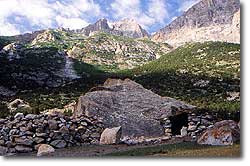 |
| Corral on high pasture |
The project involves a partnership between local farmers and a private eco-tourism company in the form of an insurance scheme. Farmers and the eco-tourism company jointly finance the insurance scheme by making contributions. The individual farmers pay premiums per head of livestock they own, while the eco-tourism company invests a part of its profits from Snow Leopard trekking expeditions. A village committee and Project Snow Leopard staff manage the insurance scheme jointly. The scheme is structured in such a way that villagers monitor each other and have incentives to avoid cheating.
The scheme comprises an institution of mutual insurance to cover against any losses due to Snow Leopard predation, and captures part of the economic value of the Snow Leopard. The expectation and rationale is that compensation through the insurance scheme will help reduce the retaliatory killings of Snow Leopards and will consequently help their conservation.
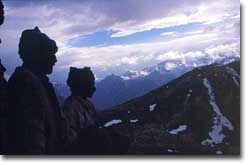 |
| Shepherds on a high pass |
Project Snow Leopard is based on a two-pronged approach: firstly, a collective insurance fund (“Fund 1”) to compensate local farmers for loss of livestock, and secondly, a fund (“Fund 2”) based on eco-tourism focusing on the plight of the Snow Leopard. Fund 1 consists of premium contributions paid by farmers per head of livestock. Fund 2, which co-finances insurance compensation if incurred losses are higher than expected, is a community-private sector partnership based on the proceeds of tourism, for example Snow Leopard treks, and may also be used to subsidize activities at the village level or be shared amongst village members.
When designing this scheme, the livelihood issues of the local people were considered. At the village level, the Snow Leopards’ predation of livestock generates a set of incentives for collective action by signalling to individuals that collective benefits can be had if they:
a. pool resources to mitigate the risk by eradicating the Snow Leopard;
b. set-up an insurance mechanism (again by pooling resources) to mitigate the risk but still try to eradicate the Snow Leopard if the opportunity presents itself;
c. set-up an insurance mechanism to mitigate the risk but endow the Snow Leopard with economic value, which can be partly captured by the locals.
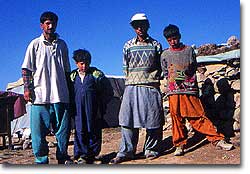 |
| Young shepherds on high pasture. |
While a and b can be achieved by the local community without outside intervention, c requires the involvement of stakeholders that can help locals capture a proportion of the economic value of Snow Leopards.
Here a clear link between institutions, incentives and collective action arises. When the risks that different individuals face are independent from one another, it will often be possible for the individuals to act collectively, to achieve a result they all prefer (Raj, 1998). Locals exposed to the risk of Snow Leopard attacks on livestock face a random shock that has an equal distribution across all farmers, but affects each one independently. At least one farmer will be hit each year with a loss. By pooling resources, that is, contributing an insurance premium towards the total loss, the risk is spread over the entire village and no individual need bear the full brunt of the risk. Moreover, if an incentive of additional income is captured, for example from eco-tourism, then the incentive for collective action to create such an institution is strengthened.
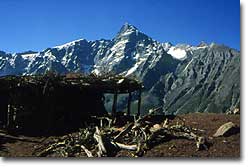 |
| A pasture hut. |
The insurance scheme is meant to be largely self-sustaining and locally managed. A Village Insurance Committee (VIC) has been set up for this purpose. The members of the VIC are from Skoyo village and have been nominated by the villagers. Claimants must formally file applications with the VIC, which verifies the killings and makes recommendations. If the VIC recommends that a claimant be compensated, then the following steps are taken:
1. The claimant receives his/her accumulated premium amount from Fund 1, as primary compensation.
2. If the claimant’s accumulated premium amount in Fund 1 is not high enough to cover the full value of the loss incurred, then money is taken from Fund 2 to cover the remaining loss.
For example, a farmer has 30 goats. In the first year, he pays 30 × PKR15 = PKR450 into Fund 1. The same year, a Snow Leopard kills two of his goats, the value of which is 2 × PKR1500 = PKR3000. The VIC verifies that the goats were killed by a Snow Leopard and approves the claim for compensation. To pay the amount agreed on, the VIC uses the total premium amount paid by the farmer into Fund 1 (ie, PKR450). The remaining amount, PKR2550, comes from Fund 2.
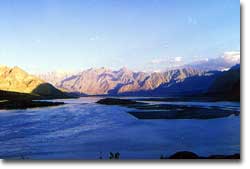 |
| Entrance to Skarpu valley. |
The VIC is the signatory on cheques written from Fund 1. For Fund 2, the VIC and the manager of Project Snow Leopard are cosignatories. Premiums are paid annually. The members of the insurance scheme are entitled to interest earned on the total amount, which is paid out annually to them in proportion to their individual accumulated premiums. Entitlement to money from Fund 2 is restricted to those members of the community who have paid premiums into Fund 1. In the case used as an example, the farmer exhausts his premiums paid into Fund 1 by receiving compensation. He must therefore make sure that he pays in the premiums on the remaining 28 goats to insure them for the following year. In such a case, the premium rate for this second payment may be higher as a result of his having received compensation the first year.
Two events since 1999 have contributed to the acceptance and sustainability of Project Snow Leopard. Firstly, successful marketing of the “Snow Leopard Trek” has generated PKR 70,000 for Fund 2. Secondly, a claim was filed against predation, where VIC's verification led to the subsequent approval and compensation payment. The insurance system passed its first test.
A follow-up strategy includes the following components:
1. Snow Leopard surveys to ensure villagers are abiding by their duty not to take retaliatory action against the Snow Leopard.
2. Further income-generating Snow Leopard treks.
3. Collection of premiums each year, providing an opportunity to review the financials of the scheme as well as to gauge villagers’ continued interest.
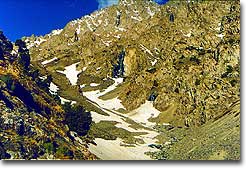 |
| Ideal snow leopard habitat in Baltistan. |
An important lesson emerging from Project Snow Leopard is the effectiveness of the innovative way of bringing together developments in the fields of community-based conservation and community-based micro-finance. Insurance can be considered a mirror image of credit. People want insurance or credit to smooth out unexpected variations in income and consumption over time. Insurance and credit provide this opportunity. What is more important, however, is that this model can form an integral component of similar community-based conservation initiatives, especially where locals see wildlife as a threat because it destroys crops or threatens human lives and livestock.
The project demonstrates a successful endeavour to overcome collective action problems. Aside from the arguments that participation is a right in itself, it is a condition for successful economic intervention. By providing a basis for an institutional arrangement (largely managed and monitored by locals) and facilitating access to otherwise remote markets, collective action among and between stakeholders is possible. More importantly, individuals interested in the global survival of the species have an entry point to the conservation efforts and collective action.
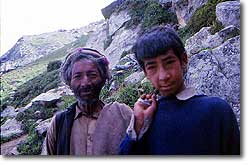 |
| Father and son in pasture. |
Arising from the lessons above, Project Snow Leopard acknowledges the need for self-sustaining public-private partnerships. There is virtually no reliance on external donors for compensation, rather Fund 1 is entirely generated from local resources. Fund 2 is a collective effort of locals and the private enterprise. A missing link has been filled by the private sector, which demonstrates and captures the economic value of Snow Leopards. With group action some of the inherent risks associated with insurance, for example fraud and cheating can be mitigated and managed.
Project Snow Leopard attempts to be self-sustaining and does not intend to rely on donor money to run the scheme. This approach however leaves the scheme exposed to potential financial crises. The income from eco-tourism is subject to many uncontrolled factors. Perceived or real security issues in Pakistan could seriously decrease the flow of tourists to the area thus leaving the scheme in risk of going bankrupt.
One of the most common features of community based conservation programs throughout the world is reliance on economic incentives to induce a pro-conservation behaviour among the people. Project Snow Leopard is also going down the same path. Whilst economic incentive is quite a powerful motive for conservation, it is not clear how it affects other non-economic incentives for conservation. It may be that other institutional motives, based on aesthetic, religious and cultural aspects get crowded out due to a heavy emphasis on economic motive alone.
Information Date: 2001-11-14
Information Source: Shafqat Hussain
- Login to post comments

Search
Latest articles
Agriculture
- World Water Week: Healthy ecosystems essential to human health: from coronavirus to malnutrition Online session Wednesday 24 August 17:00-18:20
- World Water Week: Healthy ecosystems essential to human health: from coronavirus to malnutrition Online session Wednesday 24 August 17:00-18:20
Air Pollution
- "Water and Sanitation-Related Diseases and the Changing Environment: Challenges, Interventions, and Preventive Measures" Volume 2 Is Now Available
- Global Innovation Exchange Co-Created by Horizon International, USAID, Bill and Melinda Gates Foundation and Others
Biodiversity
- It is time for international mobilization against climate change
- World Water Week: Healthy ecosystems essential to human health: from coronavirus to malnutrition Online session Wednesday 24 August 17:00-18:20
Desertification
- World Water Week: Healthy ecosystems essential to human health: from coronavirus to malnutrition Online session Wednesday 24 August 17:00-18:20
- UN Food Systems Summit Receives Over 1,200 Ideas to Help Meet Sustainable Development Goals
Endangered Species
- Mangrove Action Project Collaborates to Restore and Preserve Mangrove Ecosystems
- Coral Research in Palau offers a “Glimmer of Hope”
Energy
- Global Innovation Exchange Co-Created by Horizon International, USAID, Bill and Melinda Gates Foundation and Others
- Wildlife Preservation in Southeast Nova Scotia
Exhibits
- Global Innovation Exchange Co-Created by Horizon International, USAID, Bill and Melinda Gates Foundation and Others
- Coral Reefs
Forests
- NASA Satellites Reveal Major Shifts in Global Freshwater Updated June 2020
- Global Innovation Exchange Co-Created by Horizon International, USAID, Bill and Melinda Gates Foundation and Others
Global Climate Change
- It is time for international mobilization against climate change
- It is time for international mobilization against climate change
Global Health
- World Water Week: Healthy ecosystems essential to human health: from coronavirus to malnutrition Online session Wednesday 24 August 17:00-18:20
- More than 400 schoolgirls, family and teachers rescued from Afghanistan by small coalition
Industry
- "Water and Sanitation-Related Diseases and the Changing Environment: Challenges, Interventions, and Preventive Measures" Volume 2 Is Now Available
- Global Innovation Exchange Co-Created by Horizon International, USAID, Bill and Melinda Gates Foundation and Others
Natural Disaster Relief
- STOP ATTACKS ON HEALTH CARE IN UKRAINE
- Global Innovation Exchange Co-Created by Horizon International, USAID, Bill and Melinda Gates Foundation and Others
News and Special Reports
- World Water Week: Healthy ecosystems essential to human health: from coronavirus to malnutrition Online session Wednesday 24 August 17:00-18:20
- STOP ATTACKS ON HEALTH CARE IN UKRAINE
Oceans, Coral Reefs
- World Water Week: Healthy ecosystems essential to human health: from coronavirus to malnutrition Online session Wednesday 24 August 17:00-18:20
- Mangrove Action Project Collaborates to Restore and Preserve Mangrove Ecosystems
Pollution
- Zakaria Ouedraogo of Burkina Faso Produces Film “Nzoue Fiyen: Water Not Drinkable”
- "Water and Sanitation-Related Diseases and the Changing Environment: Challenges, Interventions, and Preventive Measures" Volume 2 Is Now Available
Population
- "Water and Sanitation-Related Diseases and the Changing Environment: Challenges, Interventions, and Preventive Measures" Volume 2 Is Now Available
- "Water and Sanitation-Related Diseases and the Changing Environment: Challenges, Interventions, and Preventive Measures" Volume 2 Is Now Available
Public Health
- Honouring the visionary behind India’s sanitation revolution
- Honouring the visionary behind India’s sanitation revolution
Rivers
- World Water Week: Healthy ecosystems essential to human health: from coronavirus to malnutrition Online session Wednesday 24 August 17:00-18:20
- Mangrove Action Project Collaborates to Restore and Preserve Mangrove Ecosystems
Sanitation
- Honouring the visionary behind India’s sanitation revolution
- Honouring the visionary behind India’s sanitation revolution
Toxic Chemicals
- "Water and Sanitation-Related Diseases and the Changing Environment: Challenges, Interventions, and Preventive Measures" Volume 2 Is Now Available
- Actions to Prevent Polluted Drinking Water in the United States
Transportation
- "Water and Sanitation-Related Diseases and the Changing Environment: Challenges, Interventions, and Preventive Measures" Volume 2 Is Now Available
- Urbanization Provides Opportunities for Transition to a Green Economy, Says New Report
Waste Management
- Honouring the visionary behind India’s sanitation revolution
- Honouring the visionary behind India’s sanitation revolution
Water
- Honouring the visionary behind India’s sanitation revolution
- Honouring the visionary behind India’s sanitation revolution
Water and Sanitation
- Honouring the visionary behind India’s sanitation revolution
- Honouring the visionary behind India’s sanitation revolution

